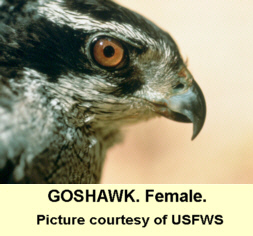
GOSHAWK.
Accipter
gentilis
‘The Cook’s Hawk’
IDENTIFICATION. A large slate grey bird, white underneath with black barring. Juveniles are brown and buff with vertical striped feathers. 'Staring' yellow eyes and a light eyebrow are typical. The 'Gos' has broad rounded wings and a long tail.
Males are much smaller, dimorphic, than the females and can be mistaken for female Sparrowhawks.
IN FLIGHT. The Goshawk is more likely to be seen in early spring when display flying takes place. Spiralling high into the air on rising thermals the 'Gos' levels out and performs a series of undulating glides across the sky. Straight line flight is a series of wing beats interspersed with long glides. The tail is drawn in and the wings become pointed to aid the glide, not unlike a Common Buzzard. Hunting is fast, furious and acrobatic.
DISTRIBUTION. A small but growing population, thanks mainly to escaped falconry birds. A bird of dense woodland the Goshawk can be seen in early spring soaring on thermals display flying.
WHEN SEEN. All year round, particularly in spring.
FOOD. Mainly birds of varying sizes. Mammals up to the size of hares (when used as falconry birds).
BREEDING. March to April. 2 to 3 pale blue eggs laid in own built nest in fork of tree. Young hatch after 5-6 weeks, flying about 45 days later.
SIZE. The largest of the true hawks 48-61cm (19-24in)
WEIGHT. 580g-1250g (1lb 4oz-2lb 12oz)
CALL. gek-gek-gek.
FALCONRY.
The Goshawk is considered by many to be the ultimate hawk an Austringer could fly. Fast, tenacious and talented there are few things a Goshawk could not catch. Hare are possible quarry for the larger females, and even pheasant in flight can be over hauled by a fit Gos. However this bird needs dedication. Quick to go wild the Gos should be handled, if not flown, daily. Another problem can be it’s highly strung temperament. A combination of stress and poor weight control can make them prone to fits, which may result in death.
If you are thinking of taking up a Gos it would be advisable to find an experienced Austringer who would be willing to show you the ropes. Also make sure you have the time, money, flying ground, a good telemetry kit, a few years experience with a Harris Hawk, Red Tailed Buzzard or even Common Buzzard and you could have the ultimate hawk.
NB. If you buy one of these raptors it should be fitted with a closed leg ring and have an Article 10 form with it (any queries check with DEFRA).
Falconry marks
![]()
![]()
![]()
![]()
![]()